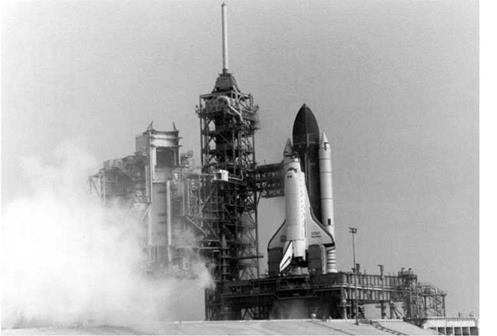STS 41-D
|
Int. Designation |
1984-093A |
|
Launched |
30 August 1984 |
|
Launch Site |
Pad 39A, Kennedy Space Center, Florida |
|
Landed |
5 September 1984 |
|
Landing Site |
Runway 17, Edwards Air Force Base, California |
|
Launch Vehicle |
OV-103 Discovery/ET-12/SRB BI-013/SSME #1 2109; #2 2018; #3 2021 |
|
Duration |
6 days 0 hrs 56 min 4 sec |
|
Callsign |
Discovery |
|
Objective |
Maiden flight of OV-103 (Discovery); satellite deployment mission |
Flight Crew
HARTSFIELD, Henry Warren “Hank”, 50, USAF, commander, 2nd mission Previous mission: STS-4 (1982)
COATS, Michael Lloyd, 38, USN, pilot MULLANE, Richard Michael, 38, USAF, mission specialist 1 HAWLEY, Steven Alan, 32, civilian, mission specialist 2 RESNIK, Judith Arlene, 35, civilian, mission specialist 3 WALKER, Charles David, 36, civilian, payload specialist
Flight Log
Scheduled for 25 June 1984, the first flight of the new orbiter Discovery was to clock up another first in space, with the transportation of the first fare-paying payload specialist. McDonnell Douglas paid NASA about $30,000 to fly Charles Walker to operate the Continuous Flow Electrophoresis System experiment, which he had helped to develop. CFES had flown before but McDonnell Douglas and NASA, both seeing the commercial possibilities, felt that CFES was on the verge of producing biological materials which could form the basis of a huge pharmaceutical space processing industry.
Walker also became the first payload specialist to make a late entry into a flight crew, which otherwise consisted of NASA career astronauts from the Group 8 cadre, which Walker himself had failed to join, and who had waited much longer to be assigned to a mission. The first launch attempt, already delayed three days, was stopped at T — 6 min by a fault in the fifth general purpose computer, and one day later, 2.6 seconds into main engine start for Discovery on Pad 39A on 26 June, engines three and two had ignited when both shut down with an alarming metallic graunching sound after the SSME 3 main fuel valve actuator channel A failed. This was the first launch pad abort in the Shuttle programme and the first in the US since
|
The first launch pad abort of the Shuttle programme was on 26 June 1984, for mission STS 41-D |
Gemini 6 in December 1965. The abort was followed by a scare when residual hydrogen gas caught fire outside the Shuttle, but in the end the crew made a graceful exit after closing out the flight deck instrumentation.
As a result of the cancellation, missions 41-D and 41-F were merged and 41-D took on more cargo. All was ready again on 29 August but launch was cancelled due to computer software problems before the flight crew got aboard. The next day, it was delayed by a further 6 minutes 50 seconds by intruding aircraft. Finally, at 07: 07 hrs local time, Discovery was airborne heading for its 28.45°orbit and a maximum altitude of 286 km (178 miles). Three large communications satellites were successfully dispatched by the gleeful crew – a Shuttle first – and a 31 m (102 ft) solar sail was unfurled from the cargo bay. The longest structure erected in space, the Shuttle Power Extension Package prototype provided 250 watts of additional electrical power.
Walker, spending most of his time in the lower mid-deck, beavered away with CFES – which he had to repair – but its hormone biological material which was to be tested for its treatment for diabetes proved to be contaminated after the flight. Venting water from the fuel cell system had caused a large chunk of ice on the outside of Discovery, which the crew removed using the RMS thus making Hawley and Mullane’s unique contingency EVA unnecessary. The highly successful mission ended at T + 6 days 0 hours 56 minutes 4 seconds on Edwards runway 17, the shortest six – crew space flight.
Milestones
100th manned space flight 43rd US manned space flight 12th Shuttle flight 1st flight of Discovery 1st Shuttle pad abort
1st flight with a commercial payload specialist











